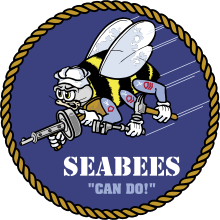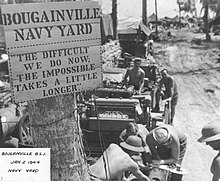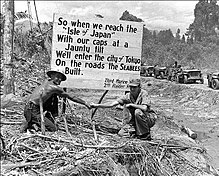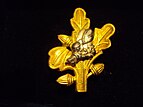
Back Seabees German Seabee Spanish Seabee French Seabees Italian シービー Japanese Seabees NB Seabees Polish Seabee Portuguese Seabees Swedish 美国海军工程营 Chinese
| Naval Construction Battalions | |
|---|---|
 The Seabee logo | |
| Founded | 1942 |
| Country | |
| Branch | |
| Type | Expeditionary Forces |
| Role | Military engineering |
| Size |
|
| Nickname(s) | Seabees |
| Motto(s) |
|
| Colors | |
| Mascot(s) | Bumblebee |
| Anniversaries | December 28, 1941 formation requested, March 5, 1942 formation authorized |
| Engagements | Guadalcanal, Bougainville, Cape Gloucester, Los Negros, Guam, Peleliu, Tarawa, Kwajalein, Saipan, Tinian, Iwo Jima, Philippines, Okinawa, North Africa, Sicily, Anzio, Normandy, Inchon landing, Khe Sanh, Dong Xaoi, Chu Lai, Con Thien, Desert Storm, Operation Iraqi Freedom, and Enduring Freedom |
| Website | www |
| Commanders | |
| Notable commanders | Admiral Ben Moreell |


United States Naval Construction Battalions, better known as the Navy Seabees, form the U.S. Naval Construction Force (NCF). The Seabee nickname is a heterograph of the initial letters "CB" from the words "Construction Battalion".[1] Depending upon context, "Seabee" can refer to all enlisted personnel in the USN's occupational field 13 (OF-13), all personnel in the Naval Construction Force (NCF), or Construction Battalion. Seabees serve both in and outside the NCF. During World War II they were plank-holders of both the Naval Combat Demolition Units and the Underwater Demolition Teams (UDTs). The men in the NCF considered these units to be "Seabee".[2] In addition, Seabees served as elements of Cubs, Lions, Acorns and the United States Marine Corps.[3] They also provided the manpower for the top secret CWS Flame Tank Group. Today the Seabees have many special task assignments starting with Camp David and the Naval Support Unit at the Department of State. Seabees serve under both Commanders of the Naval Surface Forces Atlantic/Pacific fleets as well as on many base Public Works and USN diving commands.
Naval Construction Battalions were conceived of as replacements for civilian construction companies in combat zones after the attack on Pearl Harbor. At the time civilian contractors had roughly 70,000 men working U.S.N. contracts overseas. International law made it illegal for civilian workers to resist an attack. Doing so would classify them as guerrillas and could lead to summary execution.[4] The formation of the Seabees amidst the aftermath of the Battle of Wake Island inspired the backstory for the World War II movie The Fighting Seabees.
Adm. Moreell's concept model CB was a USMC trained military equivalent of those civilian companies: able to work anywhere, under any conditions or circumstances.[5] They have a storied legacy of creative field ingenuity,[6] stretching from Normandy and Okinawa to Iraq and Afghanistan. Adm. Ernest King wrote to the Seabees on their second anniversary, "Your ingenuity and fortitude have become a legend in the naval service."[7] They were unique at conception and remain unchanged from Adm. Moreell's model today. In the October 1944 issue of Flying, the Seabees are described as "a phenomenon of WWII".[8]
- ^ "Chapter VI: The Seabees". Building the Navy's Bases in World War II: History of the BuDocks and the CEC 1940–1946. Vol. I. Washington, DC: U.S.GPO. 1947. Retrieved 18 October 2017 – via HyperWar.
- ^ 37th Seabees cruisebook, Seabee Museum Archives website, Port Hueneme, CA, Jan. 2020, p. 12-16
- ^ U.S. Marine Corps WWII Order of Battle, Gordon L. Rottman, Greenwood Press, Westport, CT, 2002, p. 32
- ^ "Seabee History: Formation of the Seabees and World War II". NHHC. 2017. Retrieved 15 March 2017.
- ^ "Admiral Ben Moreell, CEC, USN". Seabee Museum and Memorial Park. Archived from the original on 15 January 2018. Retrieved 18 October 2017.
- ^ "Coca-Cola and the Art of Seabee "Acquisition"". 15 May 2019. Retrieved 11 May 2022.
- ^ "SeaBees Name and Insignia Officially Authorized". Naval History Blog. U.S. Naval Institute. 29 February 2012. Retrieved 18 October 2017.
- ^ "The Seabees". Flying (magazine). Vol. 35, no. 4. October 1944. p. 261. Retrieved 18 October 2017.
© MMXXIII Rich X Search. We shall prevail. All rights reserved. Rich X Search

